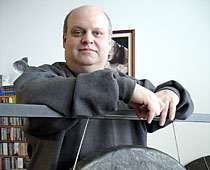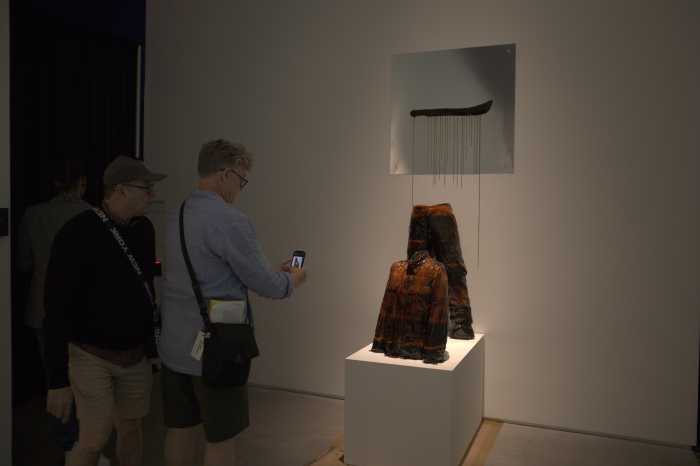When composer Gustav Mahler discussed his
complex, groundbreaking symphonies, he famously remarked that
each of them should encompass "an entire world," which
they do. He wrote 10 full-length symphonies – if you count his
massive song-cycle "The Song of the Earth" – and began
work on yet another, left unfinished when he died in 1911 at
age 50.
Musicians, composers, critics and audiences have grappled with
the legacy of Mahler’s symphonies for more than a century – in
fact, entire books have been written on their genesis, structure
and musical innovations.
Is the music world ready for another book about these titanic
works? Williamsburg resident David Hurwitz certainly thinks so.
Hurwitz – who at age 43 has already had quite a career in classical
music criticism, including an earlier book, "Beethoven or
Bust: A Practical Guide to Learning About and Listening to Great
Music" (Anchor/Doubleday, 1992), and a Web site, www.classicstoday.com,
the No. 1 classical-music internet site – has written "The
Mahler Symphonies: An Owner’s Manual," which discusses the
symphonies chronologically, with many examples of uniquely Mahlerian
features snaking their way through all his works.
Even though whole volumes could be written about each symphony,
Hurwitz doesn’t feel that he’s shortchanging Mahler – or the
reader – in any way.
"They’re not really analyses. They’re descriptions, which
is different," the author told GO Brooklyn. "Yes, these
symphonies are complex – a lot of work and art has gone into
each of them, but they’re not difficult to understand, they didn’t
become popular because they were different or alienating to people.
"I’m giving people a sense of how [the symphonies are] working
and what Mahler tried to do in each work," Hurwitz said.
"That’s why I called the book an ’owner’s manual.’ I fought
hard for that title. I wanted it to be useful on its own terms.
There aren’t really that many practical guides to Mahler’s music
because most of [the Mahler books] are technical or biographical."
Hurwitz’s qualifications to write about Mahler are impeccable.
"I’ve been listening to [Mahler’s music] since I was 12,
and I’ve performed all of his symphonies except for the Eighth,"
said Hurwitz, a percussionist. "So I know it intimately.
And some of the chapters are adapted from liner notes I’ve written
for recordings."
Mahler’s reputation is based on these 10 compositions – he also
wrote lieder and reorchestrated a few operas – and the relatively
compressed time period in which he composed them probably led
to how they sound, said Hurwitz.
"His active life as a composer only lasted 20 years and
he had very little time to write these works," said the
author, referring to his busy life as a conductor (including
two years with the New York Philharmonic), which forced Mahler
to do most of his composing during the summer months.
"These works are all related musically, and each builds
on the others," he continues. "The fascinating thing
was that his interests were eclectic – military marches, cheap
tavern music, Jewish music were all grist for his mill – but
his personality was so strong that the works share a lot of things,
like musical gestures that appear in all of them. So once you
fill out the elements of his musical language, you know all you
need to: you’re always on familiar ground."
That familiar ground is what Hurwitz explores in his "Owner’s
Manual." After all, even though the symphonies themselves
seem daunting – the shortest are the first, fourth and fifth,
each just under an hour, while the seventh and eighth usually
surpass 90 minutes in performance – they are, as Hurwitz notes,
extremely popular.
"They’re the ultimate works of orchestration for a symphony
orchestra, so logistically, they’re easy for most orchestras
to play," he said. "Audiences of the past 50 years
think they’re terrific. They’re the most popular symphonies after
Mozart’s, Beethoven’s or Brahms.’ Small community orchestras
have been playing them for years, which is amazing, considering
the amount of commitment."
The book’s accompanying CD has excerpts from four symphonies
that the reader will find useful.
"Mahler’s use of form isn’t as well known as it should be,"
Hurwitz said. "His style evolved from one work to the next,
and I wanted to show that through his music."
Hurwitz thought about including an entire symphony on the disc,
then decided movements from different symphonies would make his
point more clearly.
"[It’s like] sampling chapters [from one author], which
would work better than reading one novella in an anthology,"
he said.
Will music lovers understand Mahler’s music better after reading
the book?
"I’d like readers to come away with this thought: there’s
too much talking and not enough listening," said Hurwitz,
who has two books on Mozart and one on Czech composer Antonin
Dvorak being published this year from Amadeus Press, publisher
of his Mahler book.
"That’s especially true with Mahler: there’s too much dwelling
on the biographical aspect of his music and not enough on the
music itself, which requires that people should sit down and
listen to it," said Hurwitz. "My book relies on descriptions
with purely musical criteria because, ultimately, listeners will
listen to it that way. It is what you hear."
"The Mahler Symphonies: An Owner’s
Manual" (Amadeus Press, $19.95) by David Hurwitz is available
at local bookstores, through Music Dispatch (800) 637-2582 or
via the Web sites www.musicdispatch.com or www.amadeuspress.com.

























